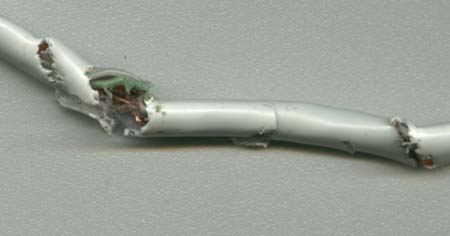|
|
|
examining a chewed cable
Thursday, January 8 2004
[REDACTED]
This afternoon I went to the house that keeps having trouble with rodents chewing through the ethernet cables strung on the outside clapboards. Nobody was there when I did my repairs, and this gave me the opportunity to snoop around and figure out an entirely different route for the cable. Earlier this summer when I did the initial work, I'd been confused by the complexity of hallways and levels between the second and third floors of the house, but now I realized that the rooms joined by the damaged outside cable actually shared a wall. So I just drilled through this wall and ran the cable indoors, out of the reach of rodents. It was a much better route this way and I was able to conceal almost all of it in a crack in a built-in bookshelf.
The weather had turned much colder in the past few days, and part of the reason I ran the cable indoors was to avoid having to work outside. But in the end I had to get up on a ladder anyway, just to know what cable I was abandoning (there were two coming in from the outdoors and they looked identical). While I was up there, I snipped off the section of damaged cable to see what it looked like (and throw it on my flatbed scanner). As I worked, a squirrel in a nearby tree hurled various insults in my direction. I think this was a Red Squirrel. Because their fur is so much thinner than that of Grey Squirrels, Red Squirrels have to eat many more nuts when the weather gets cold.
Interestingly, none of the conductors in the chewed cable looked to have been severed, though some of them were stripped of insulation and lay very close to one another. It didn't surprise me that wires in this condition would exhibit problems on a rainy day (as these had). By the way, the instructions for this wire would have you believe that it's similar to plastic hose and stops working if you kink it or bend it too sharply. But I've done all kinds of abusive stuff with this wire and I can assure you that it takes severe trauma to derail a TCP packet traveling down it.

This cable was working fine until it got rained on.
In the evening as I lay in bed, I read a fascinating article in a recent issue of The New Yorker about the human irrationality underlying the rise of the Sport Utility Vehicle (SUV). The article started out by giving us a brief account of the origin of the SUV - it's nothing more than a pickup truck with and extended cab and rows of seats where the bed would be. It then goes on to explain that there is a significant difference between the way cars and trucks are built. In the construction of trucks, supposedly far less attention is paid to things like handling, crumple zones, and center of gravity. On some level, then, they're as different from cars as motorcycles are. This allowed the author to make the point that the profit on trucks and SUVs is higher than it is on cars, because they are just easier to build. The most profitable SUVs are the luxury models like the Lincoln Navigator, which (according to the author) are simply Ford F-150 pickup trucks with a couple rows of seats in the bed, a fancy grill design, and a little sound insulation in the walls.
Further into the article, the author proposed that the rise of the SUV is a consequence of an increased feeling in America of learned helplessness. People increasingly feel that the kind of random and uncontrollable danger exhibited by terrorism is typical of danger generally. They view it as a given, and that there is nothing that can be done to avoid it, so one might as well be as protected as possible when it happens. SUVs are less maneuverable than cars (one could say that fate plays a greater role in determining where they go). So they are less capable of avoiding crashes. But when SUVs do crash, the occupants have a higher likelyhood of survival. Here the author presents an interesting chart listing car makes and models in terms of deaths per millions of drivers. The best performers here were are all small cars. Clearly, then, being able to avoid a crash contributes more to safety than being surrounded by big metal box. Thus, the author concludes, "in America people are more interested in whether they feel safer than whether they actually are safer."
The feeling of safety is related to all sorts of irrationalities programmed into our imperfect brains during times very different from now. One thing that we find comforting is being up high, and we have this feeling as a legacy of the days when we walked around and stood on things that weren't moving and whose center-of-gravity was a non-issue. Someday someone will write a book about why the human race will never transcend its many evolutionary burdens, and the irrational response to SUVs will hopefully be cited as an example.
For linking purposes this article's URL is:
http://asecular.com/blog.php?040108 feedback
previous | next |
